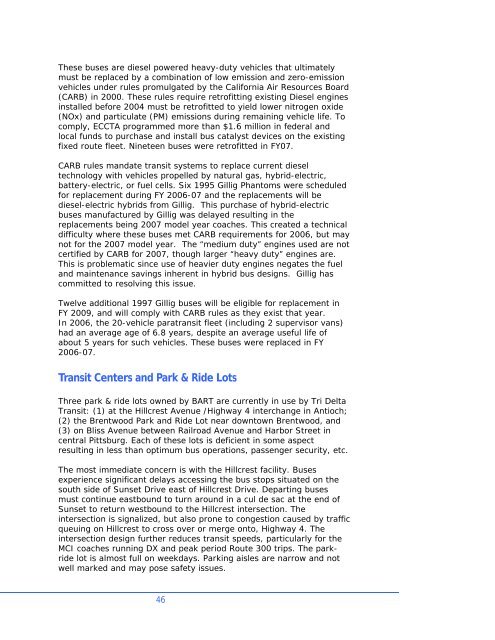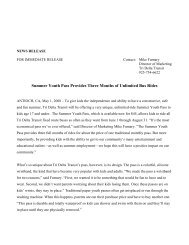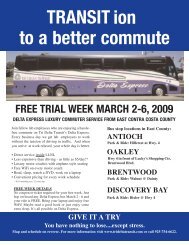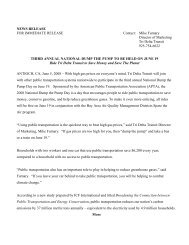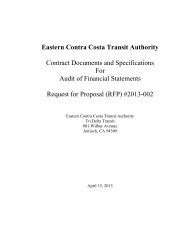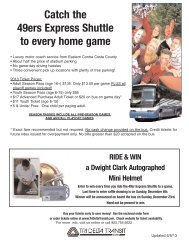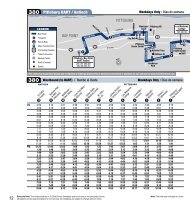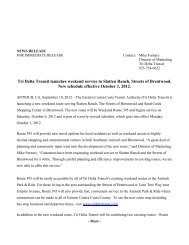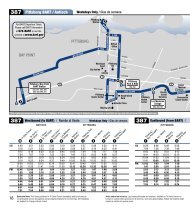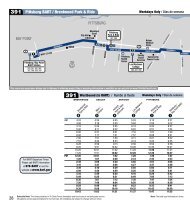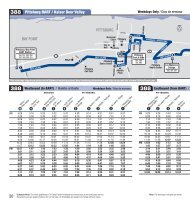to view Short Range Transit Plan FY 2007/2008 - Tri Delta Transit
to view Short Range Transit Plan FY 2007/2008 - Tri Delta Transit
to view Short Range Transit Plan FY 2007/2008 - Tri Delta Transit
You also want an ePaper? Increase the reach of your titles
YUMPU automatically turns print PDFs into web optimized ePapers that Google loves.
These buses are diesel powered heavy-duty vehicles that ultimatelymust be replaced by a combination of low emission and zero-emissionvehicles under rules promulgated by the California Air Resources Board(CARB) in 2000. These rules require retrofitting existing Diesel enginesinstalled before 2004 must be retrofitted <strong>to</strong> yield lower nitrogen oxide(NOx) and particulate (PM) emissions during remaining vehicle life. Tocomply, ECCTA programmed more than $1.6 million in federal andlocal funds <strong>to</strong> purchase and install bus catalyst devices on the existingfixed route fleet. Nineteen buses were retrofitted in <strong>FY</strong>07.CARB rules mandate transit systems <strong>to</strong> replace current dieseltechnology with vehicles propelled by natural gas, hybrid-electric,battery-electric, or fuel cells. Six 1995 Gillig Phan<strong>to</strong>ms were scheduledfor replacement during <strong>FY</strong> 2006-07 and the replacements will bediesel-electric hybrids from Gillig. This purchase of hybrid-electricbuses manufactured by Gillig was delayed resulting in thereplacements being <strong>2007</strong> model year coaches. This created a technicaldifficulty where these buses met CARB requirements for 2006, but maynot for the <strong>2007</strong> model year. The “medium duty” engines used are notcertified by CARB for <strong>2007</strong>, though larger “heavy duty” engines are.This is problematic since use of heavier duty engines negates the fueland maintenance savings inherent in hybrid bus designs. Gillig hascommitted <strong>to</strong> resolving this issue.Twelve additional 1997 Gillig buses will be eligible for replacement in<strong>FY</strong> 2009, and will comply with CARB rules as they exist that year.In 2006, the 20-vehicle paratransit fleet (including 2 supervisor vans)had an average age of 6.8 years, despite an average useful life ofabout 5 years for such vehicles. These buses were replaced in <strong>FY</strong>2006-07.<strong>Transit</strong> Centers and Park & Ride LotsThree park & ride lots owned by BART are currently in use by <strong>Tri</strong> <strong>Delta</strong><strong>Transit</strong>: (1) at the Hillcrest Avenue /Highway 4 interchange in Antioch;(2) the Brentwood Park and Ride Lot near down<strong>to</strong>wn Brentwood, and(3) on Bliss Avenue between Railroad Avenue and Harbor Street incentral Pittsburg. Each of these lots is deficient in some aspectresulting in less than optimum bus operations, passenger security, etc.The most immediate concern is with the Hillcrest facility. Busesexperience significant delays accessing the bus s<strong>to</strong>ps situated on thesouth side of Sunset Drive east of Hillcrest Drive. Departing busesmust continue eastbound <strong>to</strong> turn around in a cul de sac at the end ofSunset <strong>to</strong> return westbound <strong>to</strong> the Hillcrest intersection. Theintersection is signalized, but also prone <strong>to</strong> congestion caused by trafficqueuing on Hillcrest <strong>to</strong> cross over or merge on<strong>to</strong>, Highway 4. Theintersection design further reduces transit speeds, particularly for theMCI coaches running DX and peak period Route 300 trips. The parkridelot is almost full on weekdays. Parking aisles are narrow and notwell marked and may pose safety issues.46


